
Marion Owen:
Good coffee, island living, kayaking and more
By Marion Owen, Fearless Weeder
for PlanTea, Inc. and
Co-author of Chicken Soup for the Gardener's Soul
FEATURE ARTICLE:
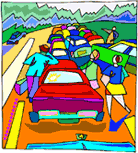
Tom Hanks' "Power of Four" solution
More good stuff:
Who is Marion Owen?
FAQs about PlanTea
Search Marion's articles, tips and recipes
Why grow organic?
News and press releases
Read love letters
How to link to this site
Need a speaker?
How to contact Marion
Visiting Alaska?
Come to Kodiak Island!
Go to home page

Marion's UpBeet Gardener
Newsletter has been
replaced by Marion's blog
which you can find at:
Marion Owen Lagniappe
Marion has a new blog. Lagniappe - Marion Owen Alaska
Charles Schultz, creator of the Peanuts comic strip, once said, "If you would read the script for a couple months you would know me." This "letting yourself show in your work" also applies to this website and my UpBeet Gardener newsletter.( I am also available as a speaker for your event or for an interview).
I love what I do. And as webmother, creator of PlanTea, book co-author, garden slave, writer and professional photographer and speaker, you will get to know me by poking around this site's articles, tips and links in this site.
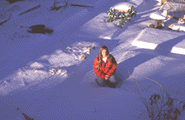
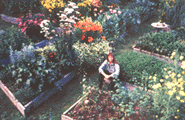
My garden in the winter, and summer -- Kodiak, Alaska
 In
1984, I move from Seattle to Kodiak Island, Alaska and I've never regretted
turning my back on malls and freeways. These days, one's desk and kitchen
sink can be anywhere in the world. It boils down to quality of life. As you read on, remember that I welcome your
emails.
In
1984, I move from Seattle to Kodiak Island, Alaska and I've never regretted
turning my back on malls and freeways. These days, one's desk and kitchen
sink can be anywhere in the world. It boils down to quality of life. As you read on, remember that I welcome your
emails.
You might be wondering how does gardening fit into all this? Well, the journey to Alaska began as far away from gardening as you can get...
From 1977 to 1985 I worked aboard research ships and tugboats. Needless to say, it was an unusual job for a woman, and I loved it. I traveled to places like Midway Island and Guam, working with oceanographers from around the world. It was on the deep blue that I mastered the art of piloting and celestial navigation. It's a magical experience to fix your position on earth by sighting on the stars.
From the ocean to the garden
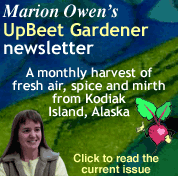 After
years working as a seaman and merchant marine officer, I missed the smell
of trees and grass, and the changing of the seasons. In 1984, I packed
all my belongings and shipped them in a containerized van to Kodiak Island,
Alaska. For the next couple years, I switched my focus to the land, driven
by the desire to grow something. So I studied everything I could find
about gardening in cool climates and asked lots of questions at garden
club meetings. I learned about gardening's Universal Law: Trial and error
is your best teacher.
After
years working as a seaman and merchant marine officer, I missed the smell
of trees and grass, and the changing of the seasons. In 1984, I packed
all my belongings and shipped them in a containerized van to Kodiak Island,
Alaska. For the next couple years, I switched my focus to the land, driven
by the desire to grow something. So I studied everything I could find
about gardening in cool climates and asked lots of questions at garden
club meetings. I learned about gardening's Universal Law: Trial and error
is your best teacher.
I wanted to grow as much of my own food as I could, because fresh produce is a valuable commodity in northern latitudes. A neighbor once told me there was a time not too long ago when she bought food for her family just once a year. She placed the order, then the groceries arrived, by boat, six months later. Back then, unless you grew your own food, all fruit and vegetables came in a can. Now of course, we have a Safeway, a Walmart, but most everything still arrives by ship.

Growing my own food wasn't enough, though. If I was going to eat it, it had to be organic, especially with genetically modified foods becoming more of a global, food safety issue. Now I have 25 raised beds filled with flowers, vegetables, fruit-bearing shrubs and a couple dozen herbs --all organically grown. It's my "teaching garden," where visitors are welcome to explore and learn.

PlanTea tea bag (Actual size is 3 x 4 inches)
This is how PlanTea, the organic plant food in handy tea bags, came to be. I loved raising my own seedlings, but I couldn't find a plant food that was organic and convenient. So, I turned a corner of my kitchen into a science lab, mixing kelp, leaves, and other goodies in my blender. You might enjoy reading the story behind PlanTea. To try PlanTea, click here.

Somewhere along the line, I started writing about my gardening experiences -- the ones that worked, and the ones that didn't. Today I write and talk about a variety of topics, from how to raise your own bedding plants and how a pencil is a gardener's best friend, to cooking and healthy living. I love developing "sneaky nutrition" recipes such as chocolate beet brownies and carrot marmalande as a way to get nutritious food into family meals.I've posted the whole list of unusual recipes.
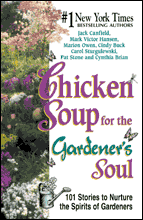
My writing and love for gardening took me places I thought I'd never go. For example, in 1998 my Mom passed away from pancreatic cancer. Though she suffered from mental illness most of her life, she was an avid gardener. One day, after working in the garden, I began to wonder if other people had inspirational gardening experiences. So, why not Chicken Soup for the Gardener's Soul? Long story short, I co-authored the book along with 5 other garden writers. Chicken Soup for the Gardener's Soul debuted in February 2001 and in 3 days we were on the New York Times bestseller list. If you'd like to read a story from the book, click here.
Back to the garden. My favorite things to grow include Oriental greens, mustard spinach, carrots, celery, all kinds of kale, potatoes, horseradish, spinach, strawberries, sugar snap peas, calendula, bee balm, beets, valerian, onions (the "long day" varieties from seed), fava beans, sweet peas and dozens of other vegetables, flowers and herbs. We can even grow globe artichokes. Examples of edible landscaping are all around the house: red and black currants, gooseberries, raspberries, blueberries, edible flowers, and let's not forget everyone's favorite -- rhubarb.
Compost is so-o-o universally awesome!
What's the secret to gardening in Alaska? Honestly, it's like anywhere else: To grow healthy plants you first need good soil. And I've never met any dirt that couldn't use a little improving. Kodiak's soil is no exception, since most of it comes from volcanic eruptions. Compost is THE answer to successful gardening, so I make it year-round from kelp, grass clippings, leaves, stable scraps (manure) and other organic materials. Just for fun, check out my article, 163 things you can compost.
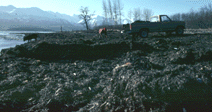
Collecting kelp on Kodiak Island beaches
Kelp, by the way, is a precious commodity to the organic gardener, as it supplies impressive amounts of minerals and nutrients. Not only is kelp is an excellent addition to compost, but it makes a great foliar spray and it's the best medium for growing potatoes. I recommend every gardener get their hands on kelp in any form--dried, powder, in PlanTea or as a bottled concentrate. In Kodiak, seaweed is available by the ton. Just drive your truck down to the beach and fill it up. It's my favorite Valentine's Day present.
How long IS the growing season in Kodiak?
Our main growing season runs from May through October, though it's possible to stretch it on both ends. I cover my raised beds with heavy, reinforced plastic secured over PVC hoops. The mini-hoophouses look like small quonset huts. They warm the soil and protects plants from strong sun, wind, hail, snow, sleet and rain. By using these season-extending tents and by selecting hardy varieties, I'm able to plant out as early as mid-April. (Here is one important key to cool climate gardening: the soil temperature needs to be at least 43 degrees F. before transplanting outside). In the fall, I re-tent several beds and to keep some plants going well into December.
During the summer, growing lettuce in Alaska is very different from say, in Wisconsin. For example, the long-g-g days allow me to pull weeds past midnight. But the increased daylight plays havoc on some varieties, causing them to bolt or to prematurely go to seed. And in case you were wondering, corn, lima beans, and watermelons don't do very well here. Then, there's the whimsical side of gardening.
Photo gallery -- snowflakes to lilies
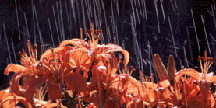
Lilies in the rain (Photo by Marion Owen)
My garden is also where I find beautiful subjects to photograph. For over 15 years, my award-winning photographs have been featured in Better Homes and Gardens, Organic Gardening, Nature Conservancy publications, Patagonia catalogs, Audubon calendars, TIME, Alaska magazine and Business Week. I really enjoy capturing a different view in my photographs: raindrops splashing off flower petals, close-ups of snowflakes, and salmon swimming underwater. I also teach photography through the university of Alaska. If you'd like to learn some photography tips, check out my photography articles.

Collage of snowflakes (Photo by Marion Owen)
Kodiak Island: Hawaii's northern cousin
Known for its brown bears, eagles, salmon and beautiful, year-round scenery, Kodiak Island is the second largest island in the United States (next to Hawaii's Big Island). Located an hour's flight south of Anchorage, Alaska's largest city, Kodiak is an easily accessible, favorite getaway.
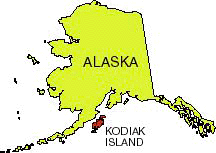
Speaking of getaways, my husband and I operate Galley Gourmet dinner cruises, whale-watching trips and overnight cruises aboard our 42-foot Grand Banks-style yacht, the Sea Breeze. Check us out at www.kodiak-alaska-dinner-cruises.com. You'll LOVE the photos!
Known as "Alaska's Emerald Isle," Kodiak is primarily a refuge for brown
bears. Kodiak played a major role in WWII, is listed in the Top 3 commercial
fishing ports in the U.S, and is a fabulous outdoor playground for sport
fishermen, sea kayakers, photographers, birders and marine mammal lovers.
Each spring, we celebrate the return of gray whales during WhaleFest.
I guess you could say I live here because I love it.
Curious about Kodiak Island? You might consider buying a copy of the beautiful
coffee table book, "Kodiak, Alaska's Emerald Isle." The book,
published by the Kodiak Chamber of Commerce,
is available from Amazon,
or by contacting the chamber at 907-486-5557 or at www.kodiak.org,
contains many of my photographs and is written by Carol Sturgulewski,
my friend and fellow co-author of Chicken Soup for the Gardener's Soul.
(You're welcome to read many stories from
the book online).
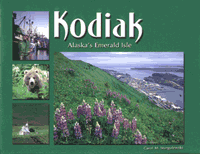
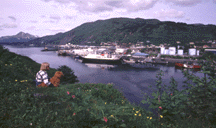
View of downtown Kodiak
If you're ever considering a trip to Alaska, be sure to pick up a copy
of THE MILEPOST. The Associated
Press calls it the "quintessential reference." First published in 1949,
even local Alaskans refer to The MilePost when planning or traveling in
Alaska, the Yukon Territory, British Columbia, Alberta and Northwest Territories.
We'll be seeing you!
Alaska Nature Photography - Alaska Photography Tips
Kodiak Island - Kodiak, Alaska
Organic Gardening Tips - Cool Climate Gardening
Healthy Cooking - Healthy Recipes
Thanks for visiting and please stop by again. I'll put the coffee on!
Meet Marion Owen /// Learn about PlanTea /// Online Catalog /// Articles, Tips, Recipes /// Get free UpBeet Gardener newsletter /// Read current issue /// Listen to radio show /// Read news and press releases /// More resources and links /// Learn why 'grow organic?' /// View guidelines for retailers /// Read love letters /// Book Marion as a speaker /// Site map /// How to link to us /// Contact us /// Go to home page
PlanTea: The organic plant food in tea bags. http://www.plantea.com
Copyright �1996 to present: PlanTea, Inc. All Rights Reserved. PO Box 1980, Kodiak, AK 99615-1980 USA
Questions or comments? marion@plantea.com Phone: Toll Free: 1-800-253-6331 (US and Canada); 907-486-2500